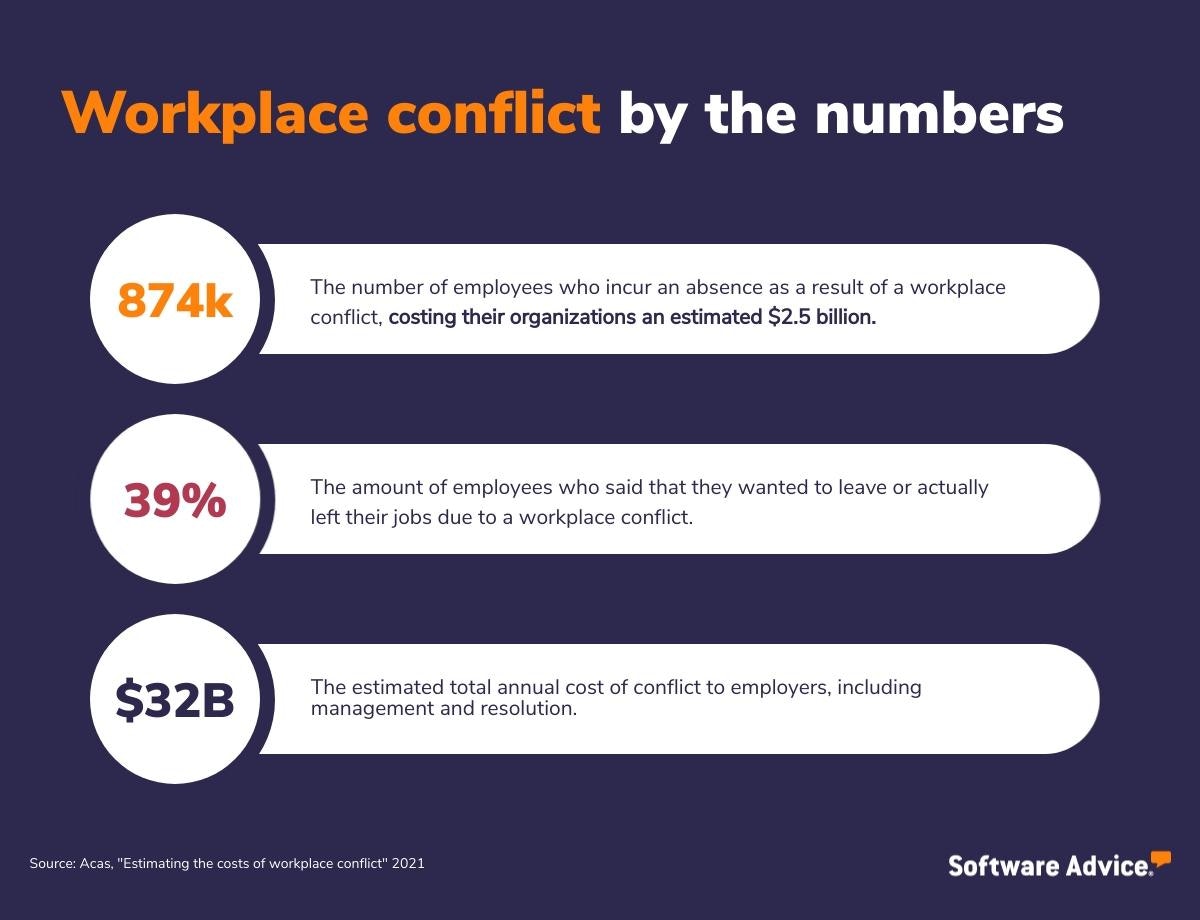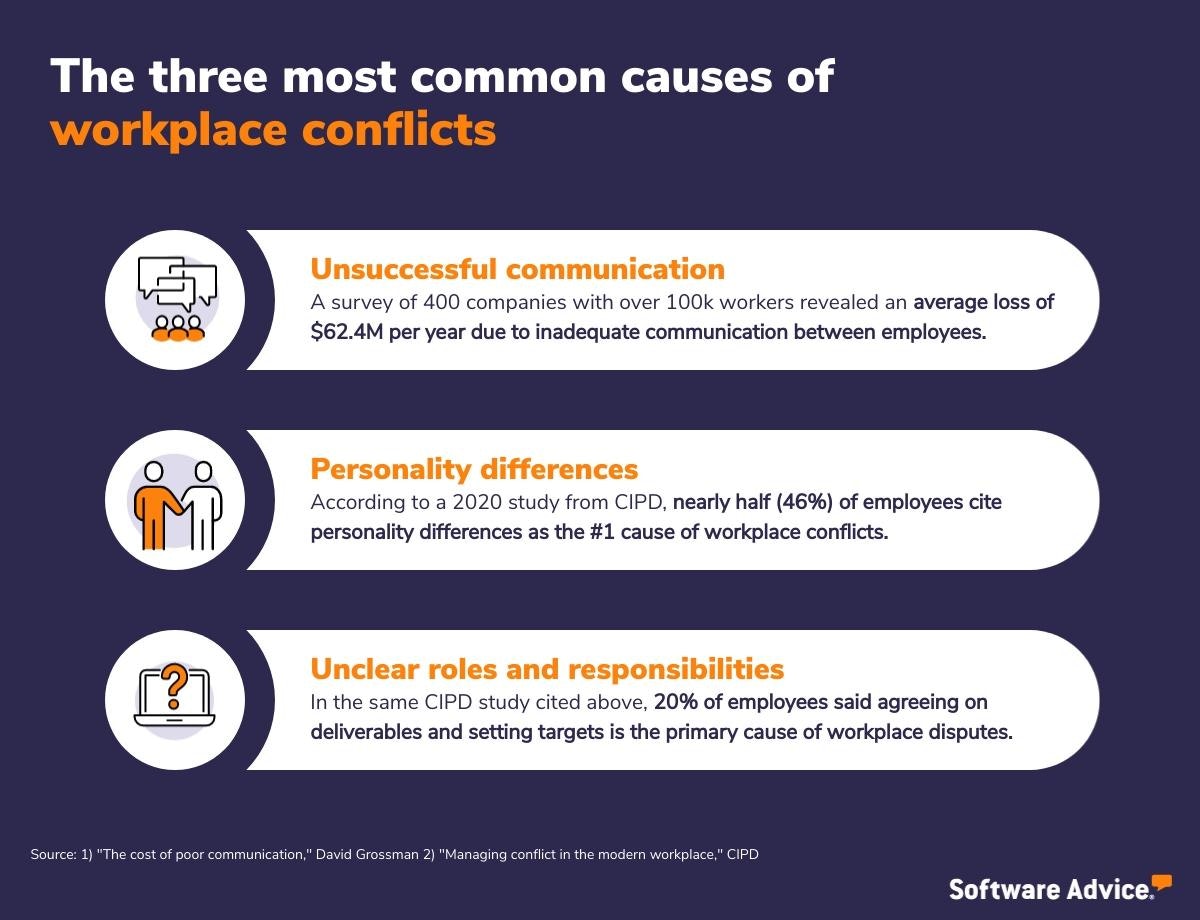What's Causing Conflict At Your Workplace? A Look At 3 Common Culprits
According to a 2021 study, 80% of remote professionals have experienced workplace conflict. That means that four out of every five remote employees have dealt with conflict during their career, which is a pretty shocking statistic considering you’d think that employees not being face-to-face would have a big impact on how frequently conflicts arise.
However, the truth is that workplace conflict is very common, and it likely always will be.
Knowing this, HR leaders and business owners wanting to create a healthier workplace should seek to understand where these conflicts come from. Whether it’s something out of your control like personality differences between co-workers or a larger issue such as an unclear division of responsibilities, uncovering the causes of conflict at your workplace will help you be better equipped to resolve them, and in turn, create a healthier workplace.
Now for some good news: We’re here to help you with that. Through research and conversations with professionals just like you, we’ve identified three of the most common causes of workplace conflict. Scroll on to get a headstart on mitigating tension in your workplace, but first, let’s talk about why managing conflict is so important.
The consequences of workplace conflict are too costly to ignore
According to the study from MyPerfectResume we referenced above, 65% of respondents’ workplace conflicts involved another co-worker. As a leader in your organization, you may be wondering: Is it my responsibility to resolve conflicts between employees?
If you’d like your business to succeed, then yes.
We spoke with Evelyn Ott, a professional tattoo artist for Soul Canvas Ink. Ott told us about her experience with two independent artists who rented space in her studio. To say these artists didn’t get along would be an understatement; the conflict between them eventually escalated to a point where they were taking one another’s supplies and clients.
“The work environment was often very weird, because they would either not be talking to each other, or they would be at each other’s throats.”
– Evelyn Ott
As you can imagine, any business would suffer from a situation like the one Ott experienced. Low employee morale, palpable tension, and a last-minute switch to a new tattoo artist aren’t exactly the customer experience clients are looking for.
Fortunately, Ott had a plan. She started by setting the expectation that each artist would need to bring their own supplies to the studio, later implementing lockable shelves for an additional level of protection.
But this is just one example—there’s more evidence out there that conflict can be costly to your bottom line and harmful to your workplace culture.

As you can see, employee conflict is extremely costly. However, you can avoid putting your bottom line at risk by mitigating organizational conflict, which begins with understanding what’s contributing to animosity at your workplace.
The 3 most common causes of workplace conflict

1. Unsuccessful communication
Almost every interpersonal conflict can be blamed (at least partially) on poor communication. This isn’t because the majority of us are poor communicators; It’s because each person has their own preferred communication style, and failing to take that into consideration can lead to unmet expectations and awkward situations.
Mike Haas, the president of Angry BBQ, shared with us a story that highlights the importance of open lines of communication. In order to maintain his business’s website, Haas works with content writers, SEO specialists, and web developers around the globe.
One day, Haas emailed his SEO team about setting a 5% target increase for conversion at the end of the quarter. Unbeknownst to him, some of his team members believed this to be too lofty of a goal.
“I only learned that my requirement was too ambitious to achieve halfway through the quarter. This was because some were afraid to speak their mind and criticize my idea. The fact that we were working on different time zones didn’t help in earning quick feedback from them, either.”
– Mike Haas
In order to resolve this, Haas and his team opted to rely on asynchronous communication through an internal communication platform going forward. This improved their team’s communication greatly, because everyone is now able to leave and respond to messages at their own convenience. Haas said:
“I realized how important it was to encourage everyone to participate in healthy discussions to learn about their viewpoint, share my perspective, and get to know them better to enhance harmonious relationships within the team.”
How to avoid conflicts due to poor communication:
First and foremost, evaluate the effectiveness of the communication channels you use. For example, if you find that important details are getting lost in your team members’ inboxes, you may need to share information another way, such as through an internal communication platform or company intranet.
Next, take time to understand each of your direct report’s communication preferences. How you like to give and receive information isn’t always going to match your co-workers’ preferences, and if you’re a manager, it’s crucial that you adapt your own style to meet your workers’ halfway. Check out Indeed’s breakdown of the four typical communication styles at work, and encourage your team to share their style and preferences with those they work with on a routine basis.
2. Personality differences
You might have a very inclusive and positive company culture, but that doesn’t change the fact that some humans are like oil and water—they just don’t mesh well together (like in the example from Evelyn Ott we covered earlier).
Personality conflicts can take many forms. For instance, if a worker with a competitive, Type A personality has to collaborate with a co-worker with a more relaxed, Type B personality, they will likely experience discord due to mismatched work styles.
In some cases, personality clashes can even escalate to the point of discrimination. Research from Gartner into how different political beliefs affect working environments revealed that in the months leading up to the 2020 election, those witnessing a colleague being called an offensive name rose from 5.6% to 13.8%. Additionally, they found that 44% of U.S. employees avoided talking or collaborating with co-workers because of their political beliefs (full content available to Gartner clients).
Obviously, discrimination and divisiveness are harmful to your workforce, so it’s essential to foster a work culture where employees are not just tolerant, but respectful and accepting of their counterparts with different personalities and life perspectives.
How to avoid conflicts due to personality clashes:
Adopt a code of conduct. Typically, a code of conduct covers policies related to things like information security and bribery, but it can also help reinforce your company’s values, such as inclusivity and mutual respect.
Actively work towards building a diverse and inclusive workforce. If you only hire people from similar professional and personal backgrounds, you are unintentionally creating a “model” for success. Employees who don’t fit that mold are less likely to be included in informal gatherings or feel satisfied with their company culture. Through building a workforce of individuals from different backgrounds, you’ll minimize in-group, out-group behavior. Get started with: How to Level Up Your Diversity Hiring Practices.
Make time for team-building activities. Whether it’s via a casual coffee chat or a more formal workshop on effective teamwork, encouraging employees to connect with one another on a personal level is one of the best ways to promote a culture of mutual respect and understanding.
3. Unclear roles and responsibilities
The overall success of your business is a function of shared responsibility and ownership, so it shouldn’t come as a surprise that when those two elements aren’t clearly defined for your employees, conflict and failure follow.
A 2020 study on workplace conflict from the Chartered Institute of Personnel and Development (CIPD) asked over 700 participants what issues the most serious incidents of conflict they experienced focused on. A fifth (20%) of respondents chose agreeing [on] deliverables and setting targets as their top driver of conflict.
This makes sense, because if you don’t clearly define the goals of a project or initiative, your team will fail before they’ve even started. Further, without defined roles and responsibilities, there is a risk of duplicated effort between your team members—or worse, overlooked tasks that delay completion of a project.
For example, air traffic controllers don’t leave it up to pilots to determine when and where to land their planes. If they did, it would be chaos on the tarmacs. Instead, they rely on the well-defined processes set by the Federal Aviation Administration to coordinate the movement of aircrafts, and ultimately, ensure the safety of crew and passengers.
All this to say that when roles and responsibilities are clearly defined, your team members can look beyond their own individual contributions and learn to understand, respect, and value the efforts of one another.
How to avoid conflicts due to unclear roles and responsibilities:
Remove ambiguity from job descriptions. Each person in your organization should know what tasks and responsibilities are a part of their day-to-day duties. While some flexibility and willingness to work outside of core responsibilities is a good thing, too much ambiguity can lead to low productivity and overworked, burnt out employees.
When in doubt, create a RACI matrix. A RACI, or responsibility assignment matrix, breaks down the various roles in completing tasks or deliverables for a project or business process. Learn more about using RACI matrices from this related content: What Is a RACI Chart? Here’s Everything You Need To Know.
Invest in a project management platform. When used effectively, project management software helps your organization define the tasks or steps in a process, assign responsibilities, and stay on track towards deadlines. If this is something your business could use help with, browse our directory of project management tools that includes options for organizations large and small.
Knowing how to resolve conflict is just as important as trying to prevent it
Understanding what causes conflict at your workplace is a good first step towards cultivating a harmonious work environment. Whenever you’re ready to take the next step, though, read our related content, A 5-Step Guide to Conflict Resolution at the Workplace.
If you’re interested in learning more about any of the software tools we mentioned in this article (such as project management platforms), we’d be happy to help. Click here to chat with one of our advisors. All you have to do is tell them your feature needs and budget, and they’ll recommend five top-rated systems that work best for your unique criteria—free of charge.